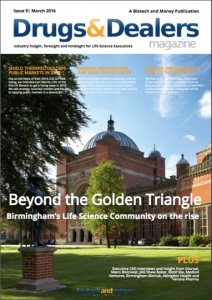Using conformational design to target a $9bn therapeutic market
C4X Discovery, a Manchester-based, AIM-listed Company which uses an NMR-based technique to optimise drug discovery, possess a unique drug discovery technology has the potential to cut preclinical development times and cost by >50% and 90%, respectively. This is particularly topical following the $100m London IPO of computational drug discovery firm Verseon in May. Here we talk to CEO Piers Morgan.
B&M: Perhaps we could open with your elevator pitch. How did C4X Discovery originate and what is your approach?
PM: C4X has developed unique technology. Many people,
particularly those in the industry are familiar with and understand
conformational chemistry. The challenge of conformational
chemistry is that you are working with certain base assumptions and the quality of your projections are then constrained by the quality of your underlying assumptions. That was where C4X came from. The founders wanted to describe the shape of particular molecules, trying conformational chemistry to capture that, but the computer modelling did not provide a good fit to the experimental data. The 2 founders then spent the next 7 years writing a completely novel mathematical approach, developing algorithms. We’re actually using experimental data from NMR machines to describe the shapes of molecules in solution.
And that’s what unique. Nobody else is able to actually measure what is really happening. The computational approach does have its uses, and we do use computational chemistry from time to time, but it’s that theoretical approach. Our NMR-based approach is empirical, it actually measures what the molecules are doing in solution.
If you take that information and give that to a medicinal chemist it makes it much easier for them to rationally design the right shape into the molecule. In a nutshell that is what C4X does. It’s using NMR data to describe the shape of molecules in solution, and then being able to take that information and use the experience of medicinal chemists to design the right shape of drug.
B&M: The application of this technology is huge and the
implications of its application across drug discovery as a whole has enormous benefit. What are the underlying benefits to this approach?
PM: Time is money. We’re able to do our lead optimisation in roughly half the time of standard approaches. In addition, one of the big challenges for industry is going through a much larger number of design cycles and testing many more changes and
taking time and effort. We make fewer than 100 compounds
compared to the full on pharma approach which can require making more than 10x as many compounds. That’s why you see this 90% cost saving for C4X compared to traditional approaches. It’s quicker, it’s cheaper and it’s also better. The Orexin programme is a fantastic example of this.
B&M: Perhaps you can explore in more detail your Orexin
programme. It’s in pre-clinical development?
PM: There are 2 receptors in the brain called Orexin 1 and Orexin 2 and they’re very similar in shape but have completely different functions. Orexin 1 is associated with the addiction-reward cycle. Orexin 2 is associated with the sleep-wake cycle. So very different.
The challenge has been to have something that hits the Orexin 1 receptor without hitting the Orexin 2 receptor and because they’re quite similar in shape that has always been very difficult. The best industry compounds we’ve found published in the literature can give you up to a 60 fold preference for Orexin 1 compared to Orexin 2. We’re seeing these compounds stop some of the addictive behaviours you see in the disease models but you can also see it’s having a sedative effect.
So industry has been trying for a number of years to develop
therapies in this area but never actually got a viable answer before. We put 1 person on it for a period of 6 months, and we were getting a thousand fold selectivity. So it wasn’t just about doing it quicker and cheaper, we were also getting to places that industry simply never got to before. It’s safer because it has less of a side effect profile.
B&M: What slice of that market do you think you’ll comfortably be able to target with these targets?
PM: The simple answer is that the overall addiction market is
approximately $9 billion and growing, but it divides into a number of different sub-markets. Nicotine addiction, alcoholism, cocaine and opiates are all areas where there is opportunity.
What we want to do is take the programme to a certain stage of development then partner with a pharma company who can decide on the detailed approach to these different market segments. Some segments like smoking cessation are very large, others like post-operative morphine withdrawal in a specialty hospital setting are smaller but could be developed fast.
I think it will be an approach that isn’t going to be hitting all $9 billion dollars in the first go, it may roll out in a number of different indications over a period of a few years.
B&M: Subject to satisfactory progression when do you
anticipate the first programme to enter clinical development? Do you have a timeline in mind?
PM: That would be second half of 2016. Pre-clinical development can take around 12 months. That’s partly because you have to run studies but also you have to manufacture larger amounts of drug substance. We’ve started that process. It will take us a few months to have the materials. In parallel we can book the slots with the service providers to run the necessary studies.
B&M: Do you think that it’s unavoidable that the life science industry will need to adopt more conformational drug discovery approaches?
PM: The cost of developing novel therapies is very expensive, costs can exceed $2 billion for each product that gets to market and I don’t think that’s a burden that society can sustain. Society bears the expense of drug development because pharma companies pass those charges on to the healthcare system when setting the price of new therapies. I think there is an
urgent need for approaches which can deliver significant cost savings.
If we’re able to generate novel, attractive lead candidates, at a tenth of the price of leading conventional approaches, that’s going to be good news for our investors, but in the medium to long term it’s probably good news for the pharma industry and it’s going to deliver a significant cost saving on to society as a whole.
B&M: You successfully IPO’ed just over 6 months ago. How has that capital been allocated or how is it being allocated?
PM: That funding is to take 2 programmes through to the clinical development. So we’re now as I said ready to get our first programme into pre-clinical development; assuming everything’s encouraging with the Orexin programme, that will then be going into clinical development in the second half of next year. We have another programme about 12 months’ behind the Orexin programme, so that second programme could be ready to follow into clinical development in 2017.
B&M: As it’s CEO, what really excited you about the potential of C4X? inhibitors you’re developing, would I be right in saying that?
PM: We have a further programme in COPD, a respiratory market which is a $45 billion market. That is giving us very encouraging data and hopefully can have some further news about that in the next few months. We also have 2 programmes in diabetes, which have been successful in obtaining funding from Innovate UK. Innovate UK has had a look at our technology and are excited by it; we have a number of other targets also. The fantastic thing about our approach is standing back, drug programmes fail at any time for any reason and you can’t predict that. What we can say is we can bring forwards a replacement programme far more quickly and financially efficiently than could be done using conventional
approaches. We have had an exciting start with the Orexin programme and are putting this compound into pre-clinical development now. We can get to that point within 12 to 24 months at a cost of a few hundred thousand pounds. That is financially so much more efficient than conventional approaches. With £11 million raised from the IPO we can be very confident we will get 2
programmes into clinical development, and several more programmes worked up and ready to go.
B&M: What is the extent of the ambition you hold for C4X.
PM: What we’re looking to do is completely demonstrate the value of our platform and convert that into a hugely valuable pipeline. Achieving this promises us a bright, independent future - I think it would be a great shame if we were to be taken out at an early stage by a purchaser. We raised £11 million at our IPO; that gives us the ability to take 2 programmes forward into clinical development. I think we can drive very attractive partnering deals from these programmes and become at that point self-financing It would make C4X an engine that produces drug candidates for areas of significant unmet medical need.
So yes, I believe we have a strong, independent future. What I would really like to do is be able to get to a point where we’ve demonstrated our technology and can then get build the additional resources to develop more than 2 programmes at a time, and take forward 5 or 6.
You can read this and 10 other exclusive executives interviews in May’s Drugs & Dealers Magazine.





Leave a comment